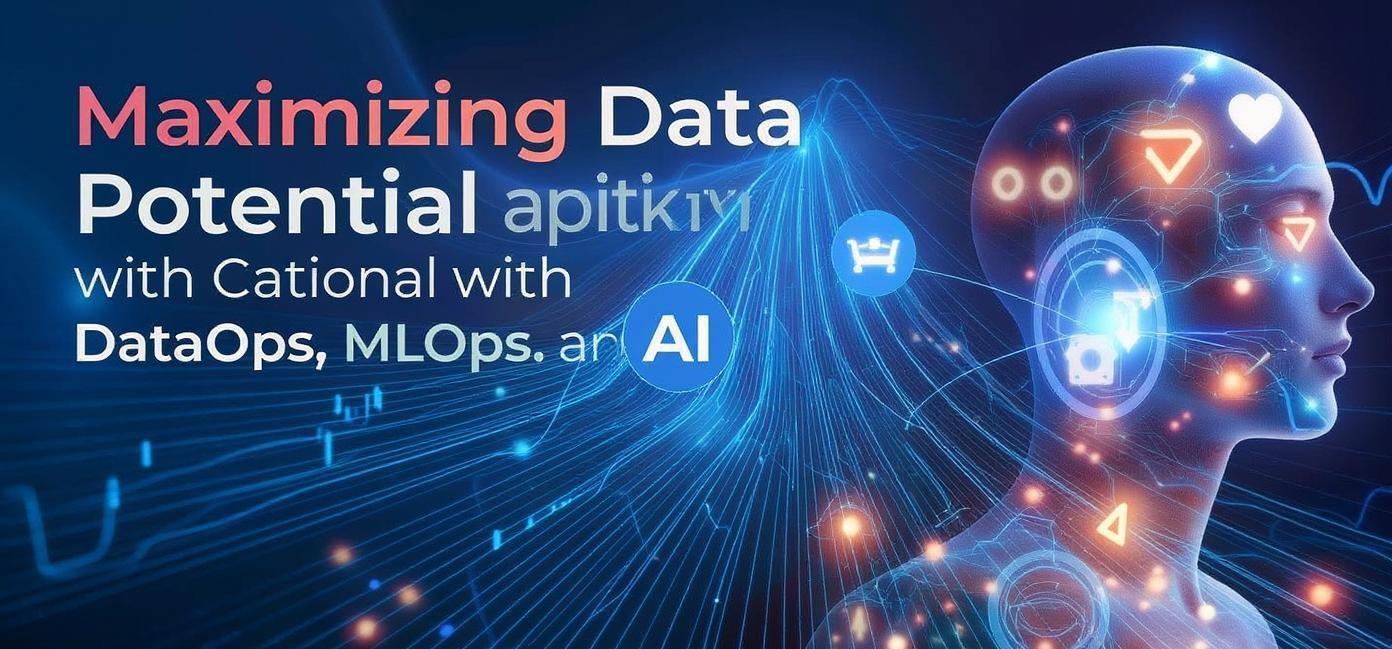In today’s digital-first economy, data has emerged as the most valuable asset for enterprises striving to gain competitive advantage, improve operational efficiency, and foster innovation. However, the sheer volume, velocity, and variety of data generated by modern organizations create complex challenges around management, integration, and actionable insights. To truly harness the potential of enterprise data, businesses are increasingly turning to integrated frameworks such as DataOps, MLOps, and Artificial Intelligence (AI). These methodologies enable streamlined data workflows, robust machine learning lifecycle management, and intelligent automation — together transforming raw data into powerful business outcomes.
The Data Challenge in Modern Enterprises
The explosion of data from sources like IoT devices, customer interactions, social media, and internal systems has overwhelmed traditional data management practices. Enterprises struggle with:
- Data silos causing fragmented information and poor collaboration.
- Inconsistent data quality leading to unreliable insights.
- Slow, manual data pipeline processes delaying analytics.
- Difficulty deploying, monitoring, and scaling machine learning models.
- Limited ability to automate decision-making in real-time.
To overcome these barriers and unlock data-driven innovation, enterprises must adopt holistic frameworks that combine process automation, governance, and advanced analytics at scale. This is where DataOps, MLOps, and AI converge as complementary approaches to maximize data potential.
DataOps: Accelerating Reliable Data Delivery
DataOps, short for Data Operations, is an emerging discipline inspired by DevOps principles in software engineering. It emphasizes collaboration, automation, and continuous improvement to manage data pipelines efficiently and reliably.
Key aspects of DataOps include:
- Automation: Automating data ingestion, cleansing, transformation, and delivery pipelines to reduce manual effort and errors.
- Collaboration: Bridging gaps between data engineers, analysts, scientists, and business teams for seamless workflows.
- Monitoring & Quality: Implementing real-time monitoring and testing of data pipelines to ensure quality and detect anomalies early.
- Agility: Enabling rapid iterations and continuous deployment of data workflows to adapt to evolving business needs.
By adopting DataOps, enterprises can shorten the time-to-insight and create trust in the data that powers analytics and machine learning. This foundation is critical for building advanced AI capabilities that depend on high-quality, timely data.
MLOps: Operationalizing Machine Learning at Scale
Machine learning (ML) has become a vital tool for enterprises to extract predictive insights and automate decision-making. However, managing the entire ML lifecycle — from model development and training to deployment, monitoring, and retraining — is highly complex.
MLOps (Machine Learning Operations) extends DevOps principles to ML systems, offering a standardized approach to operationalize ML models effectively.
Core components of MLOps include:
- Model Versioning and Reproducibility: Tracking different model versions, datasets, and training parameters to ensure reproducibility.
- Continuous Integration and Delivery (CI/CD): Automating model testing and deployment pipelines for faster, reliable updates.
- Monitoring and Governance: Continuously monitoring model performance and detecting data drift or bias for compliance and accuracy.
- Collaboration: Facilitating cooperation between data scientists, engineers, and IT teams to streamline model lifecycle management.
Enterprises employing MLOps frameworks can accelerate model deployment from weeks to days or hours, improving responsiveness to market changes. MLOps also helps maintain trust in AI-powered decisions by ensuring models perform reliably in production environments.
AI: The Catalyst for Intelligent Enterprise Transformation
Artificial Intelligence acts as the strategic layer that extracts actionable insights and automates complex tasks using data and ML models. AI capabilities range from natural language processing and computer vision to predictive analytics and recommendation systems.
When powered by DataOps and MLOps, AI solutions become more scalable, trustworthy, and business-aligned.
Examples of AI-driven enterprise benefits include:
- Enhanced Customer Experiences: AI chatbots, personalized marketing, and sentiment analysis deliver tailored, responsive interactions.
- Operational Efficiency: Predictive maintenance, process automation, and intelligent workflows reduce costs and downtime.
- Innovation Enablement: AI uncovers new business opportunities, optimizes supply chains, and supports data-driven product development.
By integrating AI into enterprise processes with the support of disciplined DataOps and MLOps practices, businesses unlock transformative potential from their data assets.
Synergizing DataOps, MLOps, and AI for Maximum Impact
While each discipline delivers unique value, the real power lies in combining DataOps, MLOps, and AI into a cohesive strategy.
- Reliable Data Pipelines with DataOps: Provide high-quality, timely data needed for model training and real-time inference.
- Scalable ML Model Management via MLOps: Ensure AI models are robust, continuously improved, and safely deployed.
- Intelligent Automation with AI: Drive business outcomes by embedding AI insights into workflows, products, and customer experiences.
Together, these frameworks enable enterprises to build a continuous intelligence loop — where data fuels AI models that automate decisions, generating new data and insights in turn. This virtuous cycle accelerates innovation, operational agility, and competitive differentiation.
Practical Steps for Enterprises to Maximize Data Potential
To implement an effective strategy around DataOps, MLOps, and AI, enterprises should consider the following:
- Assess Current Data Maturity: Understand existing data infrastructure, pipeline bottlenecks, and analytics capabilities.
- Define Business Objectives: Align data and AI initiatives with measurable goals like reducing churn, increasing revenue, or improving operational metrics.
- Invest in Automation Tools: Adopt data pipeline orchestration platforms, ML lifecycle management tools, and AI frameworks that support automation and collaboration.
- Build Cross-functional Teams: Foster collaboration between data engineers, scientists, IT, and business stakeholders.
- Implement Governance and Compliance: Establish data quality standards, security controls, and model audit trails to maintain trust.
- Focus on Continuous Improvement: Use metrics and feedback loops to iterate on data pipelines, model performance, and AI outcomes.
The Future Outlook
As enterprises continue their digital transformation journeys, the convergence of DataOps, MLOps, and AI will be essential for unlocking the full value of data. Organizations that successfully adopt these integrated frameworks will benefit from faster insights, higher quality models, and more impactful AI applications. This foundation will enable them to adapt rapidly in a dynamic market landscape and pioneer new data-driven innovations.
Read Full Article : https://businessinfopro.com/maximize-enterprise-data-potential-with-dataops-mlops-and-ai/
Visit Now: https://businessinfopro.com/


